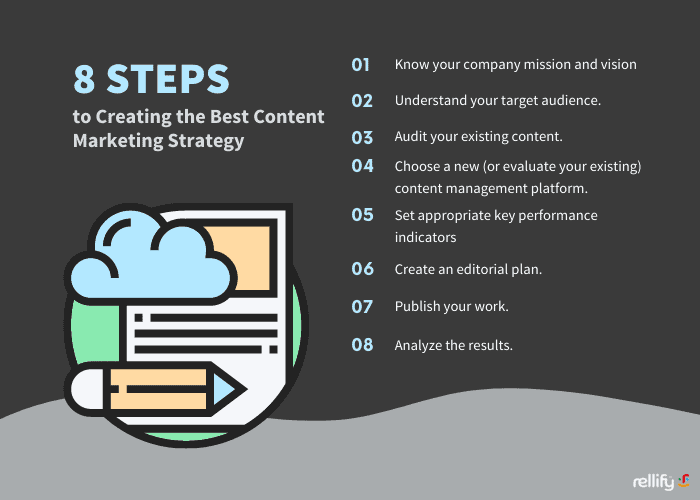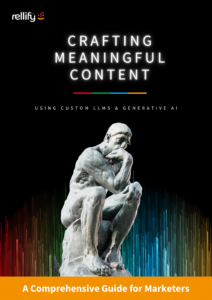Last Updated November 27, 2023 ago | Published: February 8, 2022
A successful content marketing strategy can help your company achieve its business goals. But how do you even get started? Read on for eight steps to create a content marketing strategy that delivers results.
Why does a company need a content marketing strategy?
The simple answer is that an effective content marketing strategy delivers results. Benefits of content marketing include increased organic traffic, improved brand awareness, an engaged target audience, and improved authority and expertise in your industry. One 2017 report found that content marketing generates three times as many leads as outbound marketing but costs over 60% less.
Digital marketing efforts have significantly disrupted traditional marketing. So you’re not going to have an impactful brand presence if you merely place an ad in the local paper or send out a mailer. That type of content might not drive the results you’re looking for. Instead, you need a marketing strategy that identifies and utilizes several content channels, from social media to websites.
Some experts recommend spending about 25-30% of your marketing budget specifically on content marketing. According to a 2021 survey conducted by the Content Marketing Institute, many content marketers expect their content marketing budgets to increase during 2022. So marketers are moving towards a more robust content marketing strategy.
Bottom line: a quality content marketing strategy delivers solid results for less money than outbound marketing, and more marketers are investing a considerable amount of resources into these efforts.

What are the essential elements of a content marketing strategy?
Whether you’re new to the world of content marketing or a seasoned industry veteran, a successful content marketing strategy will incorporate the eight following components.
1. Know your company mission and vision
You can’t even begin to craft a strategy if you don’t know who you are and what you want to do at a basic level. When somebody asks you what your company does or what problem they’re solving, you need to make sure you can answer succinctly. If you’re not able to do this or aren’t sure what you’re doing, how can you communicate your message?
If you work for an established brand but haven’t ever spent meaningful time going back to basics with the mission and vision, invest the energy into getting a basic understanding of who you are as a company and what you want to do.
If you’re a seasoned industry leader and you’re struggling to develop a content strategy, go back to basics and remember your company “why.” Sometimes approach alone can help spur your innovation and remind you why you’re doing the work you do. Then make sure your entire content team catches that vision so they can start or continue creating content that resonates with your end user.
This primary step is crucial for all content marketing efforts. You need to understand who you are before you can create any meaningful content.
2. Understand your target audience.

You can’t create compelling content without identifying your target audience. Think about who your end user is and how they’re interacting with your brand. You might have multiple buyer personas, but you should still cohesively present your brand and goal to create a positive customer experience.
Do competitive research here, as well. Research can help you craft a superior strategy (if you’re lucky), but it can also provide potential partnership opportunities. Are there specific influencers in your space who might be great options for brand partnerships?
For the sake of example, say you are a swimsuit manufacturer targeting moms in their 30’s. When researching your audience as part of your content marketing strategy, you discover that this market segment spends significant time on Facebook, Instagram, and Pinterest. You observe that they’re likely to follow Influencer A, B, and C on those platforms. You might also discover they’re likely to make purchasing decisions based on the same trusted people and might even buy things within those platforms. So a logical next step could be to reach out to those or similar influencers to look into mutually beneficial partnerships.
3. Audit your existing content.
Before you embark on a new content strategy, you need to undergo a content audit on the assets you already have. Does this content line up with your goals? Is it appealing to your target audience? Is your content on the content channels (i.e., Facebook, LinkedIn, Google, direct mail) where your audience can find you? What’s working, and what’s not?
Often this type of audit breaks down into three distinct categories: the content itself, the placement of your content, and the audience fit (i.e., is your content reaching the people you want to in the way that you want to.)
Which social media posts have performed well with your audience? Which blog posts are reaching potential customers through organic search? If you’ve done paid search, evaluate those metrics– what worked and what didn’t? You might find after a content audit that you might want to remove or repurpose underperforming articles. Part of your content audit should also include a technical SEO audit. That’s where you make sure your page speed is fast and performs well on mobile search and desktop.
4. Choose a new (or evaluate your existing) content management platform.
A content management platform can be an instrumental component in organizing and delivering content. Some of our favorite digital tools for content management include:
-
- Atlassian (including Trello/Jira/Confluence): These platforms help simplify communication between team members, especially when scheduling posts, recapping meetings, or brainstorming new ideas.
- Canva: an excellent platform for visual assets. It has a robust collection of stock photos and easy-to-use tools for creating video content, infographics, or presentations.
- Hubspot: This content management system assists in
- WordPress: The most widespread publishing tool. WordPress allows you to schedule, write, and publish articles. You can also add plug-ins for extra analytic data.
- rellify: The first-ever content performance platform, rellify helps users from the content ideation process all the way through analytics by combining the best of experts and machine learning.
Different businesses will have different needs for content platforms, and many platforms offer the same functionality as others. The specific platforms you end up using to enhance your content marketing strategy don’t matter as much as choosing tools that deliver the value and functionality you need.
5. Set appropriate key performance indicators
Now that you have a clear value proposition, you know all about your target audience and how to reach them, you’ve seen what you have to work with, and you’ve chosen tools to guide you on your journey, it’s a great time to figure out which key performance indicators (KPIs) really matter for your goals. Choose a few to focus on, like improving your return on investment (ROI), lowering your cost of acquisition for new users, increasing your Google impressions and click-through rate, or expanding your engagement on social.
If you choose too many KPIs or if they’re not clearly defined, then you risk getting overwhelmed and not accomplishing anything. Or, if your goals are overly vague without specifics, like making more money, you probably won’t see the results you want.
You need to understand your baseline performance before establishing new KPIs to establish realistic goals around that. If you’re only getting 50 hits on your website each week, it’s just not realistic to expect a million users a month within a year. But it might be realistic to double your website traffic each month to deliver measurable growth. You could aim to generate leads from the existing inbound traffic you’re getting or an improved ROI from your content marketing investments. Maybe you want to see 50% revenue growth by the end of the year. The specific KPIs you choose don’t matter but make sure they’re achievable and measurable.
6. Create an editorial plan.

Your editorial plan serves as the backbone for creating and distributing relevant content. It will help keep you on track, so you have an actionable plan that enables you to reach those KPIs. It will also help ensure you don’t publish too many articles on overly similar topics.
You might want a separate editorial calendar for your social media strategy and one for publishing. Since you’ve already invested the time in understanding your audience and perhaps creating a few different customer personas, you might want to promote additional content on other social media platforms.
6a. Publishing editorial plan
From a blog content side, choose a few core topics you want to write about, and determine how frequently you wish to post. Suppose you’re selling light fixtures to homeowners. You might notice you have 30 blog posts already written for your company, with topics like “The Best Lamps for Your Living Room” or “Lighting Trends.” From these examples, try to break the articles down into four categories that make sense to you and ensure you don’t only write about one facet of your work.
One lighting company might break categories down into categories like kitchen, bedroom, kids rooms, and living spaces. Another might decide it makes more sense to write about different design styles, like modern, traditional, coastal, and farmhouse. Still, another could break things down into floor lamps, wall sconces, and ceiling lamps. These organizational details don’t matter. Just make sure that you write about different topics in a way that covers everything your company offers and engages your audience.
6b. Social editorial plan
Once you have completed the editorial component of your content marketing strategy, you can start planning your social editorial calendar. If you’re in the lighting business, most of your blog articles will have strong social content, so they’ll probably be appropriate across all social channels. But your social plan should go beyond copying articles. Look for lovely user-generated content of people using your product and reshare them on visual platforms like Pinterest and Instagram. Or you can post inspiring and funny quotes or give a behind-the-scenes look at your company.
Be creative and not afraid to switch things up with this part of your content marketing strategy if some content isn’t performing as well as others. But your social strategy will be far more successful if you plan it out thoughtfully, so you don’t have ten quotes in a row or five photos of the same chandelier back-to-back. Mix things up.
7. Create and publish your work.
Once you create the editorial calendars for publishing and social, you need to write the necessary articles and find the important graphics. It’s okay if you need to tweak your editorial calendar a little bit, but make sure you have a range of high-quality content.
You’ll often publish your content across several channels and use various marketing campaigns and marketing tactics for other goals and objectives. Recycle some of your ideas and graphics, especially when you’re working on longer-form content, or even a webinar or white paper.
For example, rather than publishing this article and relevant graphics once on the website, we’ll share various links on LinkedIn. One week we might share an infographic, another a quote, and another one might be a link to the full article. Publishing the same content in different ways across different channels is a great way to maximize its impact. Some pieces of content might work best on one social media channel over another one. Others might only get traction in search engine results.
8. Analyze the results.

What gets measured gets done, and considering the blood, sweat, and tears that go into high-quality content production, you want to make sure it’s working. Every content marketer will create content that completely bombs. Not every email marketing campaign will work, and some blog posts won’t get any hits. But the analysis isn’t about eliminating failure but understanding what works, what doesn’t, and why.
You’ll have several elements to analyze, depending on how robust your content marketing plan might be. These may include:
-
- Google Analytics: This tool will let you know how different blog posts and articles on your website are performing. Other tools might also be able to give you SERPs data, but Google Analytics tends to be the most accurate.
- Google Search Console: This tool gives you deeper insights into your organic traffic. It will let you know how many organic impressions you’re receiving on various keywords, as well as the click-through rates of those items. Google search console can give you great information when it comes to choosing future keywords as you start a new content creation process.
- Facebook Analytics: You can see these to some extent through the Facebook platform. Or, you can use another content platform like Later, Hubspot, or Hootsuite to give you more data across different social media channels.
- Hubspot: This platform can provide you with lots of insights, depending on which features you’re using for your marketing strategy. Hubspot can give you data on article views or social media insights, if you’re using it to publish your content. It also provides robust information on email open and click-through rates.
Even platforms that are more concentrated on content creation, like WordPress, also have analytic components. With all of these options, and there are dozens more, you should easily be able to look at the metrics you’re interested in and see how your content is performing. You can also use some of these tools and others like SEMRush or Sistrix to track your competitors and compare the results.
How can I improve my content marketing strategy?
Now that you have these eight steps, you have the essential tools to develop a content marketing strategy that aligns with your company’s vision and goals. Look back through these steps and see which parts of your content marketing strategy seem to be working well and which parts need improvement. If you don’t quite get your objectives and mission, start there and let that form the foundation of your content marketing strategy. You might notice that your articles look good, but nobody’s reading them. In that case, check your company’s website performance and core web vitals. Then, make sure you’re promoting them on the right channels.
Unfortunately, you never quite finish improving your content marketing strategy. Sometimes Google or Facebook will change a key algorithm and your traffic will unexpectedly plummet. New technology or social platforms might impact the way you disseminate a new piece of content. So what you used to share via Facebook now works better in the form of a TikTok video. Or you might find that your consumers’ preferences change.
Whatever the case, no matter how outstanding your content marketing strategy might be today, it might need tweaks tomorrow. Be open to staying on top of your messaging and the surrounding digital marketplace.
Rellify your content marketing strategy
Keeping up with all of the necessary components of a content marketing strategy can be challenging, from content creation to planning to analysis. So if your content team needs help, be sure to contact the experts at rellify. They combine the best of expert and machine learning to deliver a strong content marketing strategy and results to their customers. So be sure to reach out to them today.

